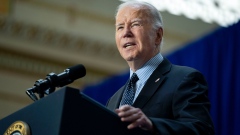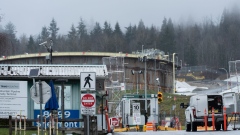Jun 5, 2023
Trudeau is betting $12.4 billion on a plan to clean up the world’s dirtiest oil
, Bloomberg News
Rushing into massive carbon capture spending would be a mistake: Cenovus CEO
Canada is staking billions of dollars of public money on an oil industry plan to transform one of the world’s dirtiest crudes into one of the cleanest. But it’s relying on a technology with a checkered track record to prolong the life of a business critics say belongs in the history books.
The tar that infuses the sands in Canada’s remote northwest is so sticky the region’s Indigenous people traditionally used it to waterproof their canoes. It wasn’t much use for anything else until the 1960s, when the oil company that became Suncor Energy Inc. found a way to refine the bitumen into crude oil that could be sold on the global market.
Today, Canada is the world’s fourth largest oil producer, but the amount of energy it takes to extract and process oil-sands barrels makes many of the region’s grades among the most polluting crudes of all. A grade called Canadian Cold Lake, for instance, released 81.87 kilograms of planet-warming carbon dioxide for every barrel produced in July 2021 — four times the emissions for a barrel from Saudi Arabia’s Ghawar field.
Under pressure to neutralize carbon emissions by mid-century while also supporting the domestic oil industry, Prime Minister Justin Trudeau’s government has so far pledged $12.4 billion in tax credits for building carbon capture systems. That includes a massive project that aims to suck up an annual 10 million metric tons of carbon emissions produced by the massive equipment at oil sands sites by 2030. By 2050, after billions more in investment, the system is expected to capture as much as 40 million metric tons of carbon annually, enough to zero out the emissions of Sweden and salvage an industry that accounts for 7% of Canada’s economy and more than a fifth of goods exports.
That’s if it works. Though carbon capture and storage technologies have been around for decades, efforts to scale them up have faced problems ranging from geological limitations to debilitating technical faults to prohibitive costs, leaving a trail of expensive, underperforming and sometimes failed projects in their wake. That makes this a high-risk strategy for the liberal Trudeau, who is unlikely to reap much political gain in conservative Alberta — the capital of the oil sands industry — if the plan succeeds, but will face criticism if it fails to improve Canada’s subpar climate record.
“They’ve had decades to get it right and yet it’s struggled,” Bruce Robertson, Sydney-based analyst at the Institute for Energy Economics and Financial Analysis, an environmental research group, said by telephone. “We’ve only got a limited amount of money and there are probably better ways to spend it.”
Robertson authored a report that examined 13 major carbon capture schemes which together account for about two-thirds of emissions ever trapped. Of those, three have performed close to or as anticipated; Sleipner and Snohvit projects in Norway and Shell’s Quest project in Alberta. The rest have either failed to achieve their targets, were shut down, never took off or there was insufficient data on their performance.
Notable poor performers include the carbon capture component of Chevron Corp.’s Gorgon liquefied natural gas project, which started operation more than three years behind schedule and failed to meet its initial targets. Equinor ASA’s In Salah carbon capture project in Algeria was shut in 2011, less than a decade after launch, amid concern about the health of the storage reservoir. In Canada, SaskPower’s Boundary Dam project at a coal-fired power plant opened in 2014 but has consistently fallen short of its target. In the oil sands, the initial plan is to capture CO2 from the upgrader facilities that turn mined bitumen into lighter crude.
The equipment will also be used to extract CO2 from steam generators at well sites, which are used to force up deeper tar deposits. So-called amine wash technology will scrub the CO2 from flue gas, transport it south through a new 400-kilometer pipeline to Cold Lake, where it will be injected more than 1,000 meters underground into an aquifer called the Basal Cambrian Sandstone formation. Construction of the pipeline is expected to begin in 2026 and Imperial Oil Ltd. expects its Cold Lake gas flue facility to be among the first sites to deploy the technology later this decade.
The Pathways Alliance, the grouping of oil sands producers behind the plan, says the vast project is unlikely to face the kind of problems seen at In Salah because the BCS reservoir is already proven. It’s nearly flat, less prone to fracturing and is being successfully used to store carbon stripped by Shell’s Quest project near to Alberta’s provincial capital of Edmonton. These facilities also won’t have to contend with the coal ash that’s interfered with the capture system at Boundary Dam.
Canada’s Minister of Natural Resources, Jonathan Wilkinson, has defended the approach as key to meeting emissions targets in a country that, despite the environmentally-friendly image of the Trudeau government, is one of the industrialized world’s climate laggards.
“For the oil sands and for many heavy industries, it is imperative that we find ways to reduce emissions. In the short term, that is almost certainly going to need to involve carbon capture,” Wilkinson said in an interview. “We’ve been using, in the oil and gas space, amine technologies for CO2 removal for a long time. The difference is scale. It’s not really about, you know, does the technology work or not.”
The oil sands presents a conundrum for Trudeau. He styles himself as a global leader on climate, and has introduced a national carbon tax and a slew of other regulatory measures to de-carbonize industry. Still, he’s struggled to get Canada’s emissions under control. Although Norway’s US$1.3 trillion sovereign wealth fund has blacklisted some oil sands producers and majors including Shell Plc, ConocoPhillips and BP Plc have sold stakes, the region is expected to keep pumping for decades, potentially frustrating Canada’s pledges to reduce its contribution to global warming. The country has set a target of cutting emissions by 40% to 45% below 2005 levels by 2030, but environmentalists warn Canada needs to take even stronger measures to hit that target, while oil companies argue it's already too onerous for their industry.
Last year, when Russia’s invasion of Ukraine caused oil to surge above US$100 a barrel, oil sands production climbed to about 3.16 million barrels a day, exceeding the pre-pandemic year of 2019, according to Alberta Energy Regulator data. Greenhouse gas emissions from well sites and mines in Northern Alberta surged to 81 million tons in 2021 — a 2 million-ton increase over 2019 — and are poised to plateau at nearly 90 million tons in the next few years, according to Kevin Birn, chief analyst of Canadian oil markets at S&P Global. Even with a carbon tax on heavy industry and an emissions cap, Birn says, carbon capture is critical for Canada to have any hope of meeting its climate pledges.
The oil sands industry is betting that the deployment of carbon capture will keep costs down as emissions levies rise, but it’s also calling for more support to keep up with the U.S., which last year announced plans to provide operating subsidies for carbon-capture systems too.
“We’ve got a very tilted playing field in North America at the moment,” Derek Evans, chief executive officer of MEG Energy Corp., said in an interview earlier this year.
That would mean even more taxpayer money going to oil companies at a time of relatively buoyant energy prices and production, money that could be channeled toward solar, wind or clean fuel technologies.
Even if Canada’s expensive carbon capture experiment succeeds, say critics, the end product is still a barrel of oil produced via open pit mines and processing facilities that have devastated local ecosystems — a barrel of oil that will be burned and emit CO2.
“A legitimate net-zero pathway for the oil and gas sector — one that aligns with international emissions accounting standards — requires addressing downstream emissions,” said Kyra Bell-Pasht, director of research and policy at Investors for Paris Compliance, which holds companies accountable to climate pledges. “What is being paraded as a net-zero pathway is deeply and fundamentally flawed.”









